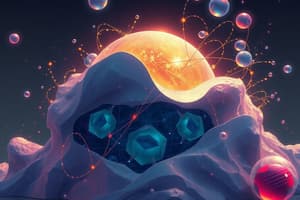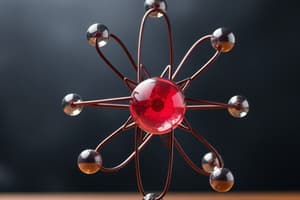Podcast
Questions and Answers
What defines an element in terms of atomic structure?
What defines an element in terms of atomic structure?
- Number of particles in a molecule
- Number of protons in the nucleus (correct)
- Number of electrons in the orbitals
- Total number of protons and neutrons
What is the primary characteristic of a solid state of matter?
What is the primary characteristic of a solid state of matter?
- Particles have no fixed arrangement
- Particles move freely in space
- Tightly packed particles with definite shape and volume (correct)
- Particles are loosely connected but in a fixed volume
Which type of bond involves the sharing of electrons between atoms?
Which type of bond involves the sharing of electrons between atoms?
- Hydrogen bond
- Ionic bond
- Metallic bond
- Covalent bond (correct)
What describes an exothermic reaction?
What describes an exothermic reaction?
What role do reactants play in a chemical reaction?
What role do reactants play in a chemical reaction?
Which of the following statements about acids is true?
Which of the following statements about acids is true?
What principle states that a system at equilibrium will adjust to counteract changes?
What principle states that a system at equilibrium will adjust to counteract changes?
What does stoichiometry involve in chemical reactions?
What does stoichiometry involve in chemical reactions?
Flashcards are hidden until you start studying
Study Notes
Basic Concepts of Chemistry
- Matter: Anything that has mass and occupies space.
- Atoms: Basic units of matter; consist of protons, neutrons, and electrons.
- Molecules: Groups of two or more atoms bonded together.
States of Matter
- Solid: Definite shape and volume; particles are tightly packed.
- Liquid: Definite volume but no definite shape; particles are close but can move past one another.
- Gas: No definite shape or volume; particles are far apart and move freely.
Atomic Structure
- Nucleus: Center of the atom containing protons and neutrons.
- Electrons: Negatively charged particles found in orbitals around the nucleus.
- Atomic Number: Number of protons in the nucleus; defines the element.
- Mass Number: Total number of protons and neutrons.
Periodic Table
- Organized by increasing atomic number.
- Groups (columns) share similar chemical properties.
- Periods (rows) indicate the number of electron shells.
Chemical Bonds
- Ionic Bonds: Formed by the transfer of electrons from one atom to another.
- Covalent Bonds: Formed by the sharing of electrons between atoms.
- Metallic Bonds: Involves the pooling of electrons among a lattice of metal atoms.
Chemical Reactions
- Reactants: Substances that undergo a change.
- Products: Substances formed as a result of the reaction.
- Types of Reactions:
- Synthesis
- Decomposition
- Single Replacement
- Double Replacement
- Combustion
Acids and Bases
- Acids: Substances that donate protons (H+ ions); have a pH < 7.
- Bases: Substances that accept protons; have a pH > 7.
- pH Scale: Measures acidity or basicity of a solution (0-14).
Stoichiometry
- Involves calculations of reactants and products in chemical reactions.
- Uses balanced chemical equations to determine molar ratios.
Thermodynamics
- Endothermic Reactions: Absorb heat (ΔH > 0).
- Exothermic Reactions: Release heat (ΔH < 0).
- Enthalpy (H): Total heat content of a system.
Kinetics
- Study of reaction rates and factors affecting them:
- Concentration
- Temperature
- Catalysts
- Surface area
Equilibrium
- Occurs when the rate of the forward reaction equals the rate of the reverse reaction.
- Le Chatelier's Principle: A system at equilibrium will adjust to counteract changes in concentration, pressure, or temperature.
Organic Chemistry
- Study of carbon-containing compounds.
- Functional groups determine the properties and reactivity of organic molecules.
Inorganic Chemistry
- Focuses on inorganic compounds, primarily those without carbon-hydrogen bonds.
- Includes metals, minerals, and organometallic compounds.
Laboratory Techniques
- Titration: Method for determining concentration of a solution.
- Chromatography: Technique for separating mixtures based on differential affinities.
- Spectroscopy: Study of the interaction between matter and electromagnetic radiation.
Safety in the Laboratory
- Always wear protective gear (gloves, goggles).
- Be familiar with Material Safety Data Sheets (MSDS).
- Know emergency procedures (e.g., fire extinguisher location, eye wash station).
Basic Concepts of Chemistry
- Matter is defined as anything that has mass and occupies space.
- Atoms are the fundamental units of matter, composed of protons (positively charged), neutrons (neutral), and electrons (negatively charged).
- Molecules consist of two or more atoms that are chemically bonded together.
States of Matter
- Solids have a definite shape and volume due to tightly packed particles.
- Liquids possess a definite volume but no definite shape, with particles that are close together yet capable of movement.
- Gases have neither a definite shape nor volume; particles are spaced apart and move freely.
Atomic Structure
- The nucleus is the atom's central core, housing protons and neutrons.
- Electrons orbit the nucleus, carrying a negative charge.
- The atomic number indicates the number of protons in the nucleus, uniquely identifying each element.
- The mass number is the sum of protons and neutrons within the nucleus.
Periodic Table
- The periodic table organizes elements by increasing atomic number.
- Groups or columns showcase elements with similar chemical properties.
- Periods or rows correlate with the number of electron shells present in the elements.
Chemical Bonds
- Ionic bonds form through the transfer of electrons, resulting in charged ions.
- Covalent bonds arise from the sharing of electrons between atoms.
- Metallic bonds involve a "sea of electrons" that are delocalized among a lattice of metal atoms.
Chemical Reactions
- Reactants are starting substances that undergo change during a chemical reaction.
- Products are the new substances generated as a result of the chemical reaction.
- Major types of chemical reactions include synthesis, decomposition, single replacement, double replacement, and combustion.
Acids and Bases
- Acids are substances that donate protons (H+ ions) and have a pH of less than 7.
- Bases accept protons and possess a pH greater than 7.
- The pH scale, ranging from 0 to 14, quantifies the acidity or basicity of a solution.
Stoichiometry
- Stoichiometry involves the calculation of reactants and products within chemical reactions using balanced equations to ascertain molar ratios.
Thermodynamics
- Endothermic reactions absorb heat, indicated by a positive change in enthalpy (ΔH > 0).
- Exothermic reactions release heat, characterized by a negative change in enthalpy (ΔH < 0).
- Enthalpy (H) refers to the total heat content within a system.
Kinetics
- Kinetics studies reaction rates and factors influencing them, such as concentration, temperature, catalysts, and surface area.
Equilibrium
- Equilibrium is established when the rates of forward and reverse reactions are equal.
- Le Chatelier's Principle states that a system at equilibrium will adjust to counteract changes in concentration, pressure, or temperature.
Organic Chemistry
- Organic chemistry focuses on the study of carbon-containing compounds.
- Functional groups significantly influence the properties and reactivity of organic molecules.
Inorganic Chemistry
- Inorganic chemistry deals with inorganic compounds, primarily those excluding carbon-hydrogen bonds.
- This field covers metals, minerals, and organometallic compounds.
Laboratory Techniques
- Titration is used to determine the concentration of a solution through controlled addition of a titrant.
- Chromatography separates mixtures based on differing affinities of components to a stationary phase.
- Spectroscopy examines how matter interacts with electromagnetic radiation for analysis.
Safety in the Laboratory
- Protective gear such as gloves and goggles is essential for safety.
- Familiarity with Material Safety Data Sheets (MSDS) is crucial for understanding hazards of substances.
- Knowledge of emergency procedures, including locating fire extinguishers and eye wash stations, is vital for safety in labs.
Studying That Suits You
Use AI to generate personalized quizzes and flashcards to suit your learning preferences.




